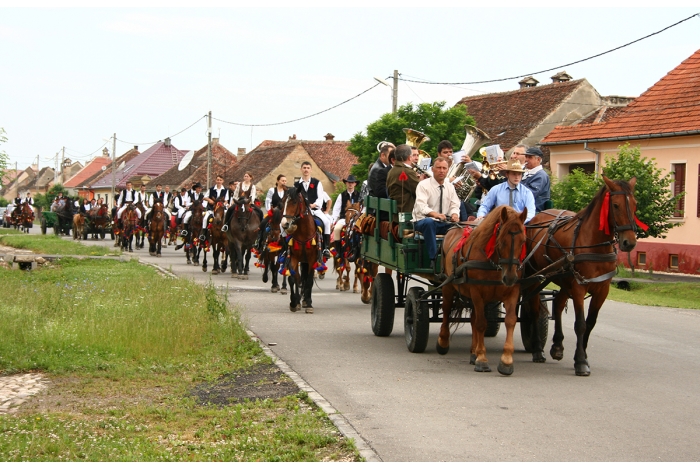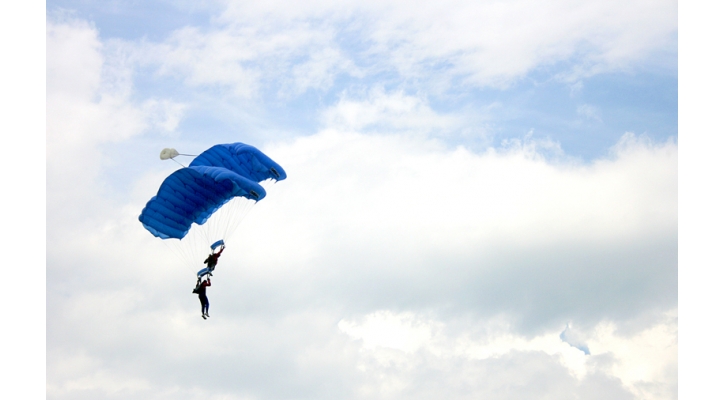Sanpetru – A Saint’s Day Festival
On the outskirts of the city of Brasov lies the small village of Sanpetru. Before the revolution in 1989, the area was home to many Transylvanian Saxons; most of these, however, immigrated to Germany during the nineties.

Junii Brasovecheni in Sanpetru. Photo by Ana A. Negru
Today, the population of the village is approximately 4,100, most of which are Romanians, only a small percentage are Saxons, with the remaining small proportion Hungarian and Rroma.
The landmark of the village is the elegant 13th century fortified church. The original 3-nave basilica was demolished in 1794; however, there are still a few traces of the original 13th century paintings on the defensive walls that surrounded the church. The architecture of the centre of Sanpetru reflects the German influence of its past, although a striking difference exists, as new and more luxurious houses have been built on the outskirts of the village.
The Sanpetru festival is an annual festival celebrating Saint Peter, from which the town was named. This year marked the fourteenth year of the festival, organised by the Town Hall and the Local Council. Each year the festival has a theme which reflects a unique aspect of the village. The event is named Ruscuta de primavara after a medicinal flower known to countries of the European Community. This rare flower grows in the Natural Reservation on Lempes hill and is one of the main tourist attractions in Sanpetru.
The celebrations ran over two days, beginning on Saturday 3rd July. The first day consisted of sporting events in the morning, with local teams competing in both Football and Rugby matches. Stalls selling traditional food and drinks surrounded the football pitch where local people enjoyed the entertainment. Throughout the evening local bands played traditional music accompanied by local singers. The day drew to a close with a fantastic fireworks display.
Sunday’s festivities began at 10 am with a tradition called Junii Sanpetrului, a combination of Romanian and Saxon traditions. Junii Sanpetrului is a parade of young men on decorated horses, as they passed through the narrow streets of the town. A horse drawn carriage led the way, with a local fanfare playing traditional music. Local people stood at their gateways watching as the procession passed by and the music filled the air.
The fanfare finished as it arrived at the local complex and the centre of the festivities. A large stage, draped in the Romanian colours, gave a real sense of pride in both the community and country. The Mayor of Sanpetru officially launched the ceremony and afterwards the entertainment got underway. Local school students performed traditional dances from the Transylvanian region.
Sanpetru is also home to an aeroclub Iosif Silimon. Created on 25th August 1937, it was the first school for gliding instructors in Romania. Today, the aeroclub attracts many visitors wishing to learn gliding, skydiving, paragliding and to fly small aircraft. As Sunday’s entertainment and music played, a fantastic aerobatics display got under way, with local aviators displaying their flying skills as they passed over the stage area. The air show was truly amazing with a constant flow of aircraft during the performances.
The festival was a fantastic display of local traditions, customs, music and entertainment, however, it was relatively unknown to people living outside the village. The festival is not openly advertised around Brasov or other parts of the country, which is a real disadvantage for the village as it really could attract a greater audience and create a real income from the yearly event. With such unique attractions, the village could really bring in tourists from across Romania or even Europe. I hope that in the future the advertising and information available about Sanpetru will improve as it really is a unique village with unique crafts and talents. For anyone wishing to experience a day out in a truly beautiful village then the Sanpetru (Saint Peter’s day) festival is definitely a date for your diaries.
by Sinead Nolan
Photos: Ana A. Negru







